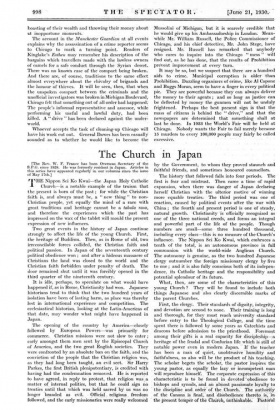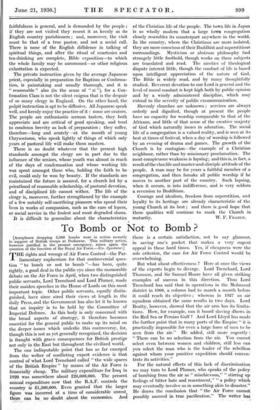The Church in Japan
[The Rev. W. F. France has been Overseas Secretary of the S.P.G. since 1928. He was formerly resident in Japan. Articles in this series' have' appeared regularly in 'our 'columns since the issue of May 17th.]
THE Nippon Sei Ko Kwai—the Japan Holy Catholic Church—is a notable example of the truism that the present is born of the past ; for while the Christian faith is, and always must be, a " new thing " to non- Christian people, yet equally' the mind• of a race with great traditions and heritage cannot be a tabula rasa, and therefore the experiences which the past has impressed on the wax of the tablet will mould the present expression of new influences.
Two great events in the history of Japan continue strongly to affect the life of the young Church. First, the heritage of Buddism. Then, as in Rome of old, two irreconcilable forces collided, the Christian faith and political passion. In Japan of the seventeenth century political obedience won ; and after a hideous massacre of Christians the land was closed to the world and the Christian faith forbidden under penalty of death. The door remained shut until it was forcibly opened in the third quarter of the nineteenth century.
It is idle, perhaps, to speculate on what would have happened if, as in Rome, Christianity had won. Japanese historians tend to think that the two hundred years Of isolation have been of lasting harm, as place was thereby lost in international experience and competition. The ecclesiastical historian, looking at' the Latin-Americas of that date, may wonder what might have happened in Japan.
The opening of the country by America—closely followed by European Powers—was primarily for commerce. Christian missions were not slow 'to enter ; early amongst them men sent by the Episcopal Church of America, and the two great English societies. They were confronted by an absolute ban on the faith, and the conviction of the people that the Christian religion was, as they had long been taught, an evil sect. Sir Harry Parkes, the first British plenipotentiary, is credited with having had the condemnation removed. He is repeated to have agreed, in reply to protest, that religion was , a matter of internal politics, but that he could sign no treaties until that which was held sacred by us was no longer branded as evil. Official,. religious _ freedom followed, and the early missionaties-w'ere really; welcomed by the Government, to whom they proved staunch and faithful friends, and sometimes honoured counsellors.
The history that followed falls into four periods. The first is fear and mistrust. Then came a time of rapid expansion; when there was danger of Japan declaring herself Christian with the ulterior motive -of winning more equable treaties. The 'third period was one of reaction, caused by political events after the war with China ; the fourth- and present period is one of steady, natural growth. - - Christianity is -officially recognized as one of the three national creeds; and forms an integral and powerful part of the life of the people. Though numbers are small-----some three hundred thousand, including every class—this is no measure of the Church's influence. The Nippon Sei Ko Kwai, which embraces a tenth of the total,' is an autonomous proVince in full communion with the world-wide Anglican Church. The autonomy is genuine, as the two hundred Japanese: clergy outnumber the foreign missionary clergy by five to one ; and it is also fully conscious both of its indepen- dence, its Catholic heritage and the responsibility and potential splendour of its future.
What, then, are some of the characteristics of this young Church ? They will be found to include both things Japanese and also clearly discernible marks of the parent Churches.
First, the clergy. Their standards of dignity, integrity, and devotion are second to none. Their training is long and thorough, for they must reach university standard before entry to the Theological College, and the time spent there is followed by some years as Catechists and deacons before admission to the priesthood. Foremost among their giftS is a real capacity for discipleShipa heritage of the feudal and Confucian life which is. still of notable power' even modern odern Japan. If the teacher has been a man of quiet, Unobtrusive humility and faithfulness, so also will be the product of his teaching. The scholar begets 'the 'scholar, the pastor 'inspires the young pastor, as eqUally the lazy or inCoMpeterit man will reproduce himself. , The corporate expression of this characteristic is to be found in devoted obedience to bishops and synods; and an almost passionate loyalty to the diScipline and order of the Church." The authority of the Canons. is 'final; and cliiobedience thereto_ is, in the present temper of the Chtifeh, unthinkable: Pastoral faithfulness is general, and is demanded by the people ; if they are not visited they resent it as keenly as do English country parishioners ; and, moreover, the visit must be that of a true pastor, and not a social call. There is none of the English diffidence in talking of spiritual things, and after the ritual of courtesies and tea-drinking are complete, Bible exposition—to which the whole family may be summoned—or other religious exhortation is expected.
The private instruction given by the average Japanese priest, especially in preparation for Baptism or Confirma- tion, is painstaking and usually thorough, and it is " reasonable " also (in the sense of " ri "), for a Con- firmation Class is not the silent enigma that is the despair of so many clergy in England. On the other hand, the pulpit instruction is apt to be diffusive. All Japanese speak well, and keenly enjoy the practice of it : some are orators. The people are enthusiastic sermon tasters, they both appreciate and are critical of good speaking, and tend to condemn brevity as lack of preparation ; they suffer, thereforelong and acutely —at the mouth of young Chrysostoms, who speak lightly of things of which only years of pastoral life will make them masters.
There is no doubt whatever that the present high standards amongst the clergy are in part due to the influence of the seniors, whose youth was almost in reach of the days of condemnation and whose working life was spent amongst those who, holding the faith to be evil, could only be won by beauty. If the standards .are maintained the future is assured, for a church led by a priesthood of reasonable scholarship, of pastoral devotion, and of disciplined life cannot wither. The life of the clergy is, moreover, further strengthened by the example of a few notably self-sacrificing pioneers who spend their lives in works of compassion, such as the care of lepers, or social service in the foulest and most degraded slums.
It is difficult to generalize about the characteristics of the Christian life of the people. The town life in Japan is so wholly modern that a large town congregation closely resembles its counterpart anywhere in the world. In the country, where the Christians are more isolated, they are more conscious of their Buddhist and superstitious surroundings. Mysticism or abstruse philosophy find strangely little foothold, though works on these subjects are translated and read. The niceties of theological dispute interest little, though the conduct of life is based upon intelligent appreciation . of the nature of God. The Bible is widely read, and by many thoughtfully studied. Reverent devotion to our Lord is general and the level of moral conduct is kept high both by public opinion and by a wisely administered discipline, which may extend to the severity of public excommunication.
Slovenly churches are unknown ; services are always orderly and dignified, though at present the people have no capacity for worship comparable to that of the Africans, and little of that sense of the creative majesty of God which naturally issues in adoration. The social life of a congregation is a valued reality, and is seen at its best at times of festival, when a day of worship is followed by an evening of drama and games. The growth of the Church is by contagion—the example of a Christian neighbour, rather than by missionary proclamation. The most conspicuous weakness is lapsing; and this is, in fact, a result of the clan life and master-and-disciple attitude of the people. A man may be for years a faithful member of a congregation, and then forsake all public worship if he moves to another part of the country. Such lapsing, when it occurs, is into indifference, and is very seldom a reversion to Buddhism.
Courage and idealism, freedom from superstition, and loyalty to its heritage are already characteristic of the young Church at its best ; and there is good hope that these qualities will continue to mark the Church in









































 Previous page
Previous page